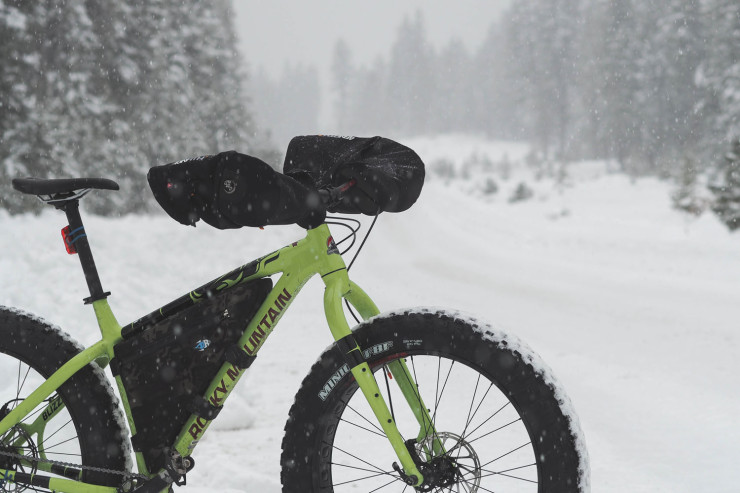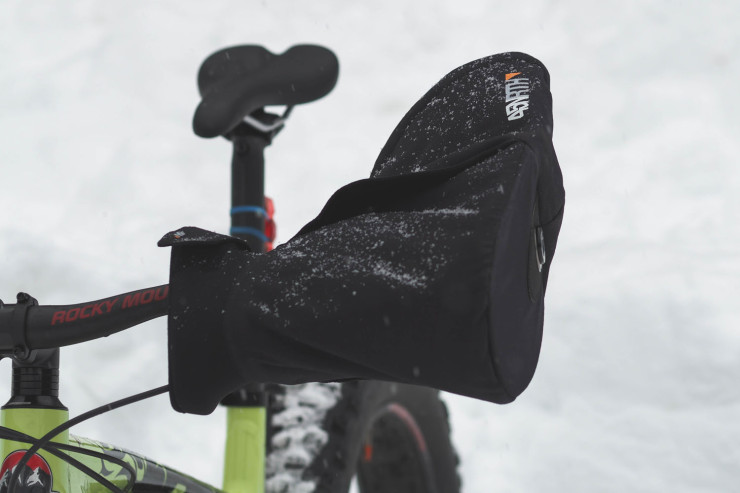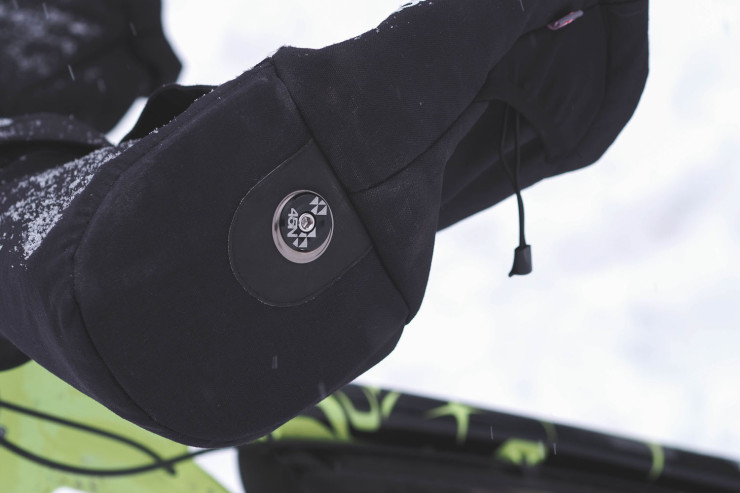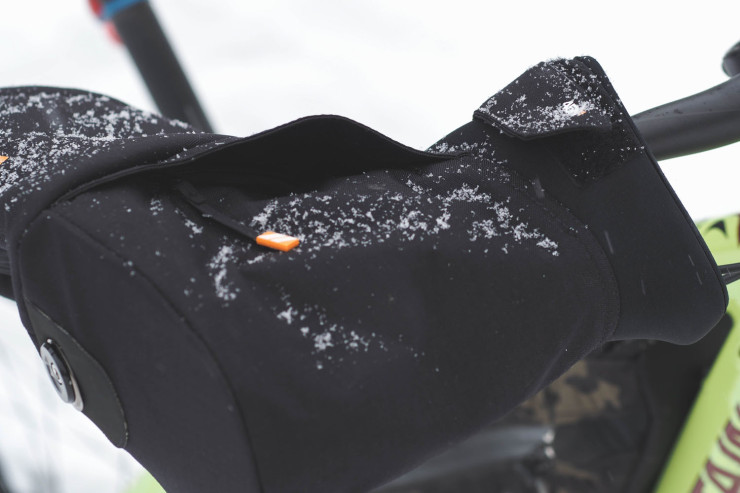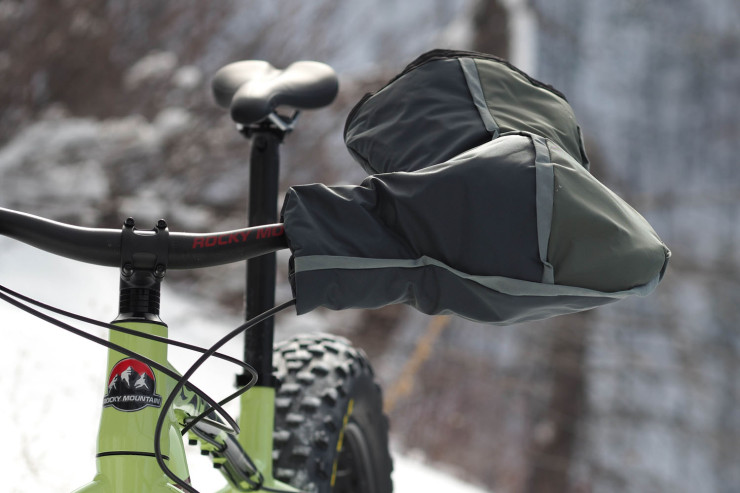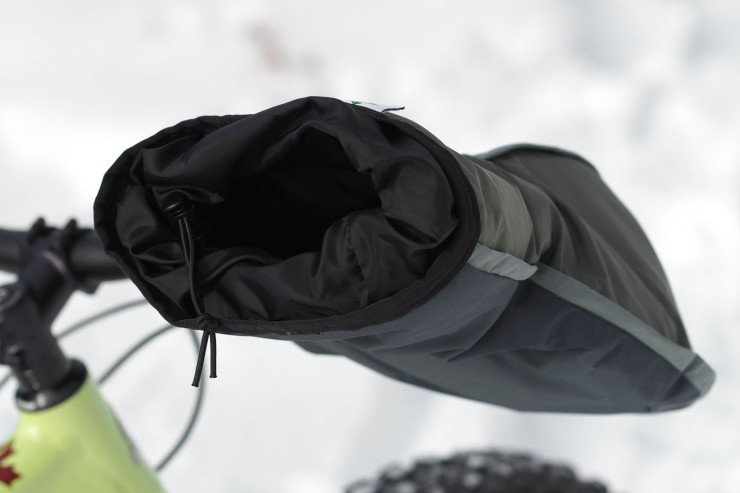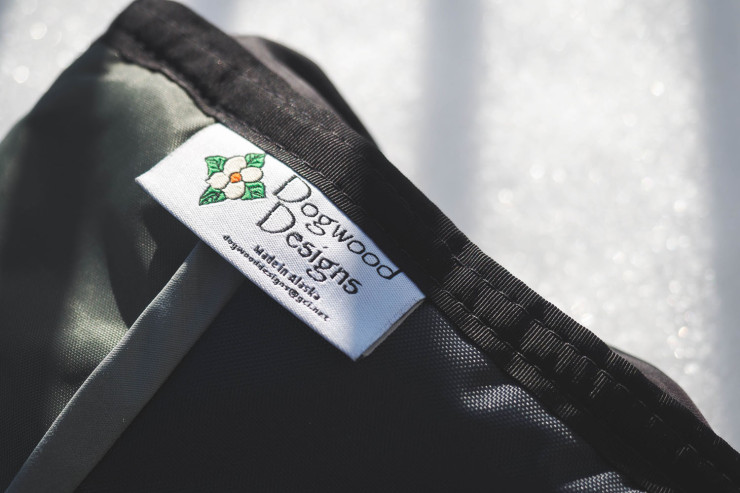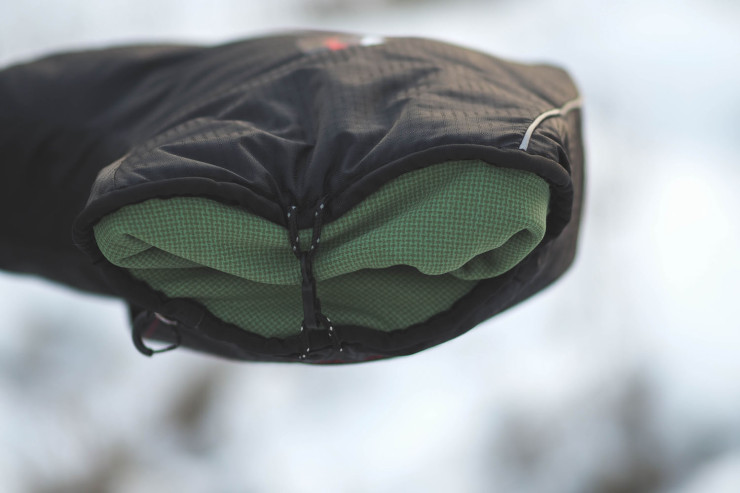Pogies: A Funny Looking Necessity
You thought you got some puzzled looks while riding your fat bike? Try strapping some boxing glove sized sleeping bags to your bars. It’s easy to scoff at cycling pogies, as they can first appear cumbersome and a bit overkill. But, the truth is, they work. Miles had the chance to test out three of the best pogie options available from Revelate Designs, 45NRTH, and Dogwood Designs. Here are thoughts on each as well as a history of these curious mitts…
PUBLISHED Feb 15, 2017
It doesn’t take a dedicated cyclist long to figure out what parts of their body get cold first. You’ve likely experienced numb toes and fingers in the fall and early spring. I know I have. But you can typically get to camp and use a warm sleeping bag to shake off the chills. But miles of cycling in unrelenting sub-zero temps makes winter bikepacking a little less forgiving when it comes to dealing with the elements. That’s where heavy duty gear comes into play.
In my case, the first ride this year that got me thinking about ways to keep warm involved a dusting of snow, a light breeze, and a 0°C forecast. It led to some fairly frigid fingers, and out came the winter gloves. But this made it difficult to shift, brake, and do pretty much anything else with my hands. Enter pogies.
Pogies are essentially spacious pockets for your hands, grips, brake levers, and shifters, made with fabrics that act as a barrier from the outside weather. The microclimate within the pogie is sealed from the elements, and when your hands warm up inside the pogie, they stay warm and keep all the controls warm in the process. Pogies are ideal for cycling in temperatures between 0°C and -30°C (32° to -22°F) when winter gloves are not quite enough. Modern winter cycling pogies usually offer three main features:
- 1. A weather and wind resistant exterior shell.
- 2. A light synthetic or down insulating layer (light is surprising I know, but the windproof layer does most of the work and the insulation is kept fairly minimal).
- 3. Full, unrestricted access to your levers, shifters, and grips.
Not only will I share my experience using three proven pogie options — each with these qualities and more — I’ll try to shed some light on how the cycling pogie came to be, and their undeniable ties to Alaskan-based manufacturers that could teach the rest of the world something about cooperation.
How The Pogie Came To Be
Cycling pogies are a relatively new item in the commercial marketplace. They’ve only become readily available across the US and Canada in the past few years. During my research, I found many suggestions that the cycling pogie was essentially just adopted from the paddling pogie that had already existed years before. Although the paddling pogie may have had some influence, after speaking with Joan Skilbred at Dogwood Designs, I believe we have a handful of diehard Alaskan cyclists to thank for the modern cycling pogie we see today.
Winter cycling is nothing new for the people of Alaska. It started with various iterations during the Klondike Gold Rush in the 1890s, but wasn’t until the early 1990s that Fairbanks began to see more experimentation with bike components and lubricants to make winter riding more feasible. Soon after, Apocalypse Designs, a gear manufacturer in Fairbanks that’s still in business today, started commercially producing pogies to help combat cold hands. These early designs worked great, but as you can imagine, there was room for improvement.
This is when Dogwood Designs joined the story. At that time — approximately 25 years ago — Dogwood had been operating as a custom sewing business out of Fairbanks that catered primarily to the dog mushing community. Just like the dog mushers that braved the Alaskan winters, cyclists wanted a pogie that would allow them to go further and stay warmer. Over the next seven years, Dogwood Designs worked closely with a bike shop in Fairbanks to design the modern pogie.
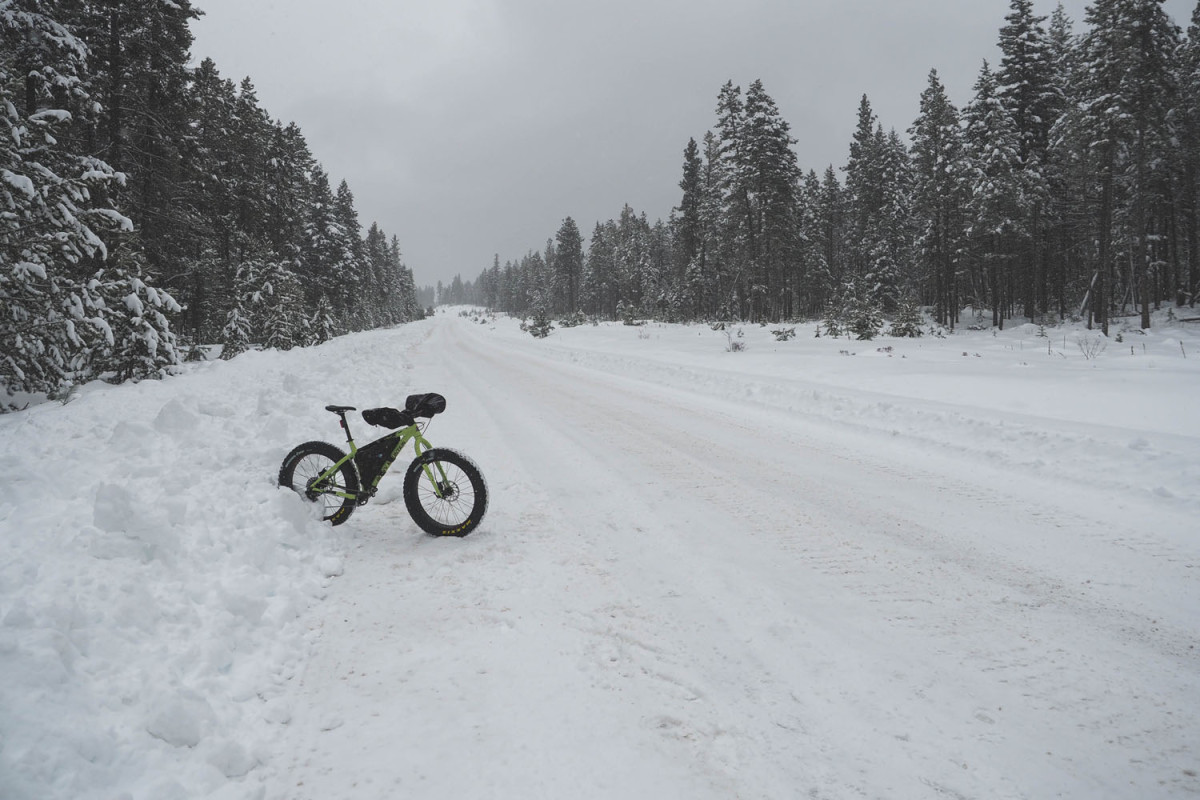
Born in Alaska
All this talk of Alaska-based gear manufacturers like Apocalypse Designs, Dogwood Designs, and of course Revelate Designs, got me interested in the commercial scene. Joan continued to explain that although there aren’t many manufacturing businesses in Fairbanks, the ones that exist all agree that quality products are the main driving force. Winter cycling and the innovation to make it possible evolved symbiotically, which created a demand for better performing products. Many of these products, such as the pogie, will become worldwide industry standards, while some won’t make it out of the city they were designed in.
“Amongst the manufacturers here in Alaska, there is an informal sense of cooperation. Occasionally, we have helped each other out, and have also respected our separate niche specialties. This spirit of passive cooperation has enhanced the development of these products and has also generated the healthy business climate that exists here today for creating and supplying these products.” – Joan Skilbred, Dogwood Designs
Alaska has cold winters, and there are cyclists who continue to ride despite the frigid weather. Whether you spell it “poagie” or “pogie,” you can rest assured that Alaska had something to do with it.
Three Pogies Tested
After testing three of the best and top-rated commercially available pogies, here are some thoughts on each — in alphabetical order — and matrices with price, weight, temperature details, and materials. In addition, you can find a list of other available pogies at the bottom of the page.
45NRTH Cobrafist
Bloomington, Minnesota
Quality Bicycle Products (QPB) launched 45NRTH in 2012. Sitting alongside brands like Salsa and Surly, 45NRTH focuses specifically on winter cycling clothing, tires, footwear, and accessories. As you’d expect, they’ve positioned themselves at the forefront of technical winter gear, and this definitely rings true with the Cobrafist pogie.
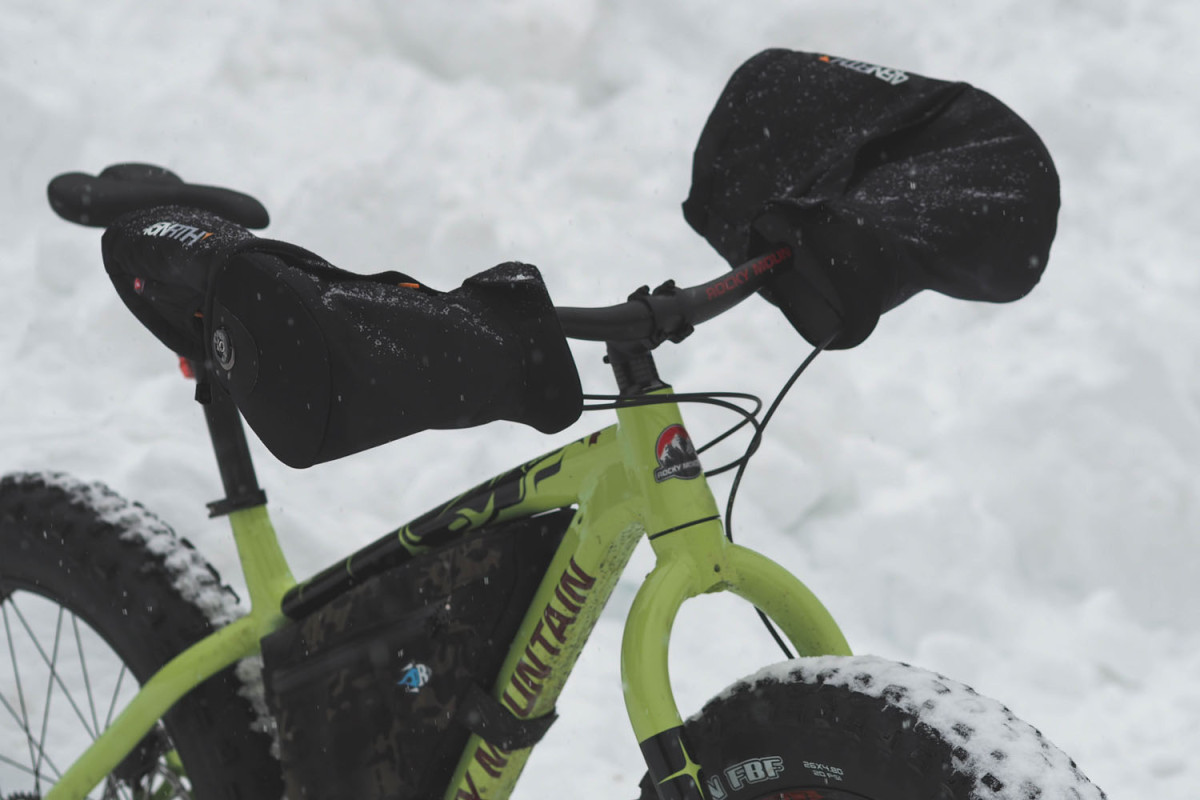
If you like the newest, the most fancy, and gear with lots of features, then the Cobrafists are definitely for you. Perhaps one of the most notable features is the upper and lower zippered vents, giving easy temperature control when your hands get too warm. This is especially important for moisture control when riding technical terrain. 45NRTH uses 400g of PrimaLoft insulation, which continues to offer your hands warmth even after it gets wet. I will admit they weren’t as warm as the other pogies tested, but depending on where you live, this could be seen as a positive if you’re looking for dependable protection with substantial ventilation.
The Cobrafists keep on top of the trends by including internal mesh storage pockets to keep things organized around the levers, shifters, and grips. Unlike the other two pogies tested, 45NRTH added a required locking bar end plug that ensures they stay in place, but still allows some swivel room as you move in and out of the saddle. I first set them up with my girlfriend outside in -20°C, and although installing the bar end plugs and foam donuts required some adjustment of the levers and shifters to get it set up right, my hands were only cold for a short while. Something important to note is that the Cobrafists require the foam donuts and bar end plugs in order to function properly. This isn’t important if you plan to leave them on your bike all winter, but, as I’ve been switching between the three over the past few months, it added an extra step and is something to consider.
- Outer Shell: 600d tear-resistant poly (Cordura)
- Lining: 68d lightweight poly
- Insulation: 400g PrimaLoft Eco Gold
- Manufacturer’s Temp Rating: 15°F to 0°F (-9°C to -18°C)
- Our Recommended Rating: 32°F to -13°F (0°C to -25°C)
- Special Features: PrimaLoft insulation, zippered vents, lock-on design.
- Weight: 680g (24oz)
- Price: $125 USD / $165 CAD
- Contact: 45NRTH.com
Dogwood Designs Original Bike Poagie
Fairbanks, Alaska
Although Dogwood Designs is the only manufacturer to include the a in poagie, their design takes on a less-is-more attitude, which I believe to be their greatest strength. After talking with Joan Skilbred from their Alaska-based shop, it’s clear that they’ve put some serious thought into the current design of their poagie.

The original Bike Poagie, at first glance, may look like it’s missing some features that others offer – no extra storage areas, dedicated vents, or bar-end locks, and a slightly saggy stance without having your hands on the bars. However, limiting zippers and pockets means the poagie is easy to use. Ventilation is achieved by adjusting the shock cord closure around the wrist gasket and the bars, and internal elastics keep the poagies where they need to be. A lightweight polyester skeleton creates and maintains space around the hands, but still allows the poagie to sag downwards to keep any falling snow from getting inside.
An added bonus is the option to customize your poagies. Your first decision is choosing between the original poagies (rated for -26C / -15F) or the poagies plus, that use a high-loft insulation designed for extreme cold riding, but would be too warm for anything above -17°C / 0°F. I don’t live in Alaska, so the original poagie was fine for me. I had the option to include reflective trim on the exterior of the main body, which I think is a no-brainer for some added visibility. Things could have got out of control quickly with the huge list of colours available, so I decided to go with a charcoal body and military gray green side panel. I’d love to see some in safety orange and hot pink, though.
When we tried adding other features, it would compromise warmth, so we kept the priority on warmth performance.” – Joan Skilbred, Dogwood Designs
- Outer Shell: 200d – 430d nylon
- Lining: 110d taffeta nylon
- Insulation: 12oz polyester batting
- Manufacturer’s Temp Rating: down to -26°C/-15°F
- Our Recommended Rating: down to -30°C/-22°F
- Special Features: extremely user-friendly design, custom-made options, simple.
- Weight: 370g (13oz)
- Price: $110 – $170 USD / $145 – $225 CAD
- Contact: dogwooddesigns@gci.net
Revelate Designs Expedition Pogies
Anchorage, Alaska
Revelate’s Expedition Pogies are indeed created with expedition-style bikepacking in mind. A simple and durable design paired with the features you’ll appreciate on longer, colder trips makes for a versatile and incredibly warm option for riders tackling some epic winter rides.

Riding with the Expedition Pogies in the -5°C to -10°C (23°F to 14°F) range allowed me to leave the included fleece liner at home, and ride with bare hands or summer cycling gloves. I’d often start my ride with light fleece gloves on, which always ended up living inside the pogie, waiting for me for when I needed my hands again. If my hands were too warm, I’d loosen off the strap on the cable exit hole to increase the draft entering the pogie. Riding in temperatures between -15°C and -25°C (5°F to -13°F) required the addition of the fleece liner or a fleece liner glove, which comes down to personal preference. My thought was I’d prefer to have a light glove on just in case I needed my hands suddenly on the trail. With the included fleece liner installed, there isn’t a lot of extra space around the levers. It’s not restrictive in any way, but I definitely found the setup much cleaner with a fleece glove instead.
I rarely had any problem removing my hands from their microclimate within the pogie when I needed to, and cramming my hands back inside was a breeze (even if I couldn’t feel said breeze). The zippered pocket features an expandable design, and although I would avoid packing anything too heavy here, they make for an ideal spot for snacks, electronics, or even packable layers.
Revelate includes a set of foam plugs that further insulate your hands from intruding breezes by way of the cable exit, and bar-ends that secure the inside of the pogie to reduce sagging. The Expedition Pogies offer some highly desirable features in a clean and simple overall design, which I believe to be important for longer trips where I don’t want to be dealing with more than what I need.
- Outer Shell: 210d ripstop nylon
- Lining: 70d taffeta nylon
- Insulation: quilted 340g synthetic + removable Polartec 300 liner
- Manufacturer’s Temp Rating: -9°C/16°F without liners to -45°C/-49°F with liners
- Our Recommended Rating: -5°C/23°F without liners to -40°C/-40°F with liners
- Special Features: removable liner, external zippered storage, expedition-friendly design.
- Weight: 686g w/liner, 492g w/o
- Price: $225 USD / $297 CAD
- Contact: RevelateDesigns.com
Wrap Up
Something important to take into consideration is how well pogies interact with a bikepacking setup. I used the pogies on both 760mm and 780mm bars, which are definitely at the wider end of the spectrum. All of the pogies left just enough room to properly mount a handlebar harness, with room for one cockpit accessory on each side of the stem. Each set of pogies does have slightly different dimensions, so this should only play a role in your decision if you are using bars narrower than the ones mentioned above, or you have a particularly busy cockpit area on your bike.
Overall, I was impressed by each of the three pogies I tested. It’s the simplest way to ensure your hands stay warm and protected in the winter, and although each offering has slightly different features, they’re all game changers for winter bikepacking. It’s up to you to decide if you require loads of ventilation (45NRTH Cobrafist), an expedition-friendly and versatile modular design (Revelate Designs Expedition Pogie) or the simple, ultra-warm classic and customizable option from Dogwood Designs. Either way, they are all proven, quality designs. For commuting, I really liked Dogwood’s classic Poagie because of how easy it was to remove and install. For a bikepacking trip I did in January, Revelate’s Expedition Pogie was great because of the added insulation and included storage. And for technical singletrack and day rides, 45NRTH’s Cobrafists were unbeatable.
More Pogies
There are several other great pogie options available on the market. Here is a list we started. If you have any other suggestions, we’d love to hear about them in the comments below. What features do you look for? Give us your suggestions and we’ll add them to the list!
| Pogies | State | Country | Price | Temp Rating | Weight | Link |
|---|---|---|---|---|---|---|
| 45NRTH Cobrafist | MN | USA | $125 | ? | 680g | link |
| Alpine Threadworks Powderface Pogies | AB | CAN | $112 | -10°F | ? | link |
| Alpkit Bear Paws | KZ | UK | £85 | ? | 240g | link |
| Apocalypse Designs Toasties | AK | USA | $84+ | ? | ? | link |
| Bar Mitts Standard | NV | USA | $75 | ? | ? | link |
| Bar Mitts Extreme | NV | USA | $125 | ? | ? | link |
| Bedrock Bags Redwall Pogies | CO | USA | $85 | -10°F | 206G | link |
| Ceunik Artik Voyager Pogies | ON | CAN | $83+ | ? | ? | link |
| Dogwood Designs Original Poagie | AK | USA | $110+ | -15°F | 370g | link |
| HotPog Arctic Pogies | NH | UK | $106 | ? | ? | link |
| MEC Northstar Cycling Pogies | n/a | CAN | $30 | ? | 285g | link |
| Moose Mitts | MI | USA | $95+ | ? | ? | link |
| Portland Pogies Cordura Pogies | OR | USA | $55 | ? | ? | link |
| Revelate Designs Expedition | AK | USA | $225 | -50°F | 686g | link |
| Revelate Designs Williwaw Pogies | AK | USA | $120 | 0°F | ? | link |
| Wolftooth Singletrack Pogie | MN | USA | $100 | ? | 280g | link |
Please keep the conversation civil, constructive, and inclusive, or your comment will be removed.
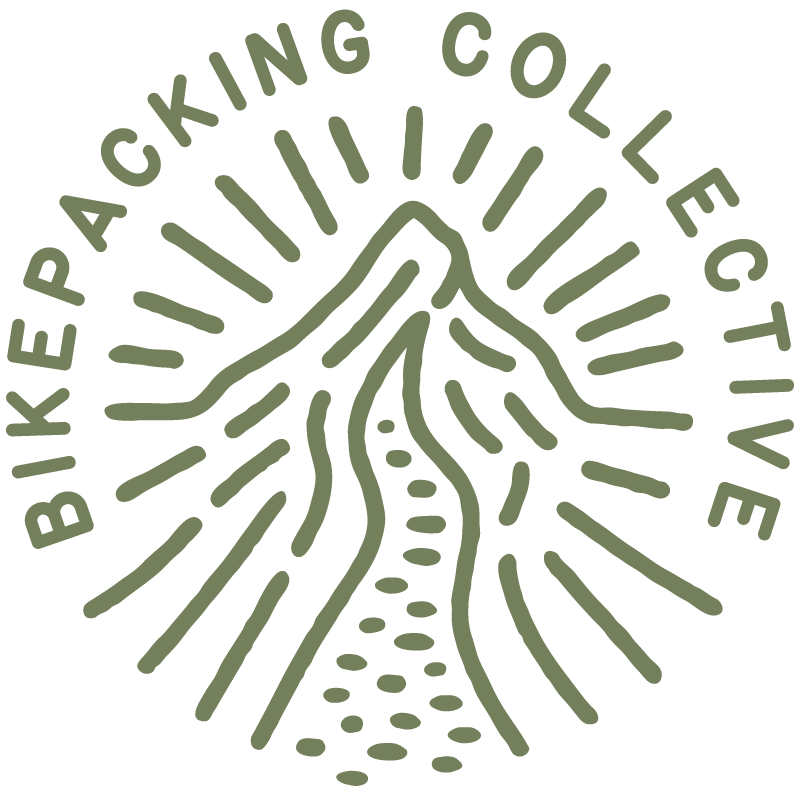
We're independent
and member-supported.
Join the Bikepacking Collective to make our work possible:









